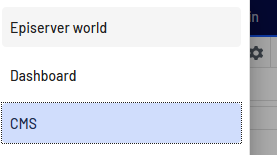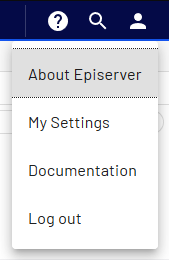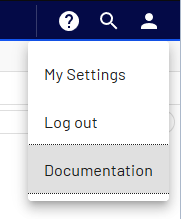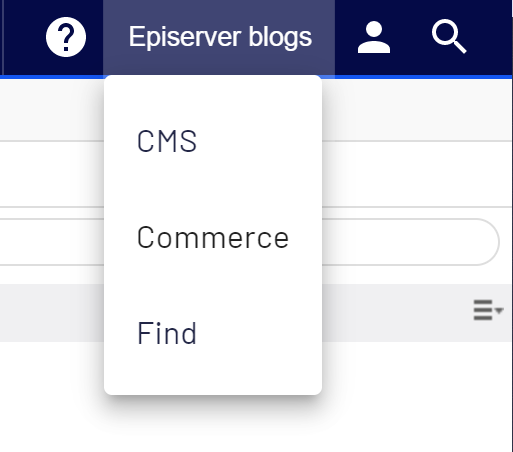Add and configure menu items
Describes how to add and set up menu items.
MenuItem attribute
Use MenuItem on MVC controllers. MenuItem adds links to the top menu (and requires the module to be registered; see Configuring Shell modules. The required menuPath parameter is a logical path of the menu element in the menu. Optionally, you can add the Url parameter to specify the linked URL to the interface. By default, the URL is set to the registered shell route for the module (/EPiServer/{ShellModule}/{controller}/{action} for protected modules and /modules/{ShellModule}/{controller}/{action} for public modules).
The following example adds a menu item to the top menu bar with the text Start and infers the URL from the registered route for the shell module:
public class DashboardController: Controller {
[MenuItem("/global/dashboard", Text = "Start")]
public ActionResult Index() {}
}When you add menu items, you need to implement the page to include Optimizely Content Management System (CMS) styling for the shell and render the menu so you can return.
The key function to render a menu is @Html.CreatePlatformNavigationMenu().
Note that the calls to Html.ShellInitializationScript() might still be needed depending on what content you are showing in addition to the navigation menu. It is not necessary for the navigation menu itself.
In addition to Html.CreatePlatformNavigationMenu, you also need to wrap content below the menu in an element decorated by using this HTML helper html.ApplyPlatformNavigation().
NoteThe Platform Navigation font sizing uses REM and expects the root element to have size 16px (browser default). Some style frameworks, such as Bootstrap 3, override the root font size while others, like Bootstrap 4, do not.
To adapt the example above to work with versions 11.21 and higher, you need to start using CreatePlatformNavigationMenu() and ApplyPlatformNavigation(). Note that you no longer need @Html.Raw(ClientResources.RenderResources("Navigation")) nor @Html.Raw(Html.ShellInitializationScript()):
@using EPiServer.Framework.Web.Resources
@using EPiServer.Shell.Navigation
<!DOCTYPE html>
<html>
<head>
<title>@ViewBag.Title</title>
<meta http-equiv="X-UA-Compatible" content="IE=Edge" />
<!-- Shell -->
@ClientResources.RenderResources("ShellCore")
<!-- LightTheme -->
@ClientResources.RenderResources("ShellCoreLightTheme")
</head>
<body>
@Html.CreatePlatformNavigationMenu()
<div @Html.ApplyPlatformNavigation()>
@RenderBody()
</div>
</body>
</html>Localize menu items with the MenuItem attribute
You can localize menu items by specifying TextResourceKey. By default, is the key resolved against LocalizationService. Alternatively attribute ResourceType can be specified that they should be a class a with a static property named TextResourceKey that returns the localized text.
Example:
[MenuItem("/global/dashboard", TextResourceKey = "Start", ResourceType = typeof(MenuResources))]Organize menu items
The menu path organizes menu items in a tree structure. Menu items in the top menu are in the /global bucket. The next segment is the name of the menu section, for example, /global/cms. The last segment represents the actual user interface, for example, /global/cms/edit.
Permissions with the MenuItem attribute
By default, CMS applies this security policy to shell module controllers. You can configure the policy through attribute authorizationPolicy in module.config. You can then evaluate the availability of the menu item through the policy. You can apply the AuthorizeAttribute to specify a custom authorization to complement the default policy that applies to the module. Note, however, that if there is a policy for the shell module, it also evaluates that policy for the request.
public class DashboardController: Controller {
[MenuItem("/global/dashboard")]
[Authorize(Roles = "SomeGroup")]
public ActionResult Index() {}
}Examples
Global menu button

namespace Alloy.Business {
public class EpiServerWorldGlobalMenuItem: Controller {
[MenuItem(MenuPaths.Global + "/globalLink", SortIndex = SortIndex.First - 10, Text = "Optimizely world",
Url = "https://world.episerver.com/cms/")]
public ActionResult Index(string viewName) {
return View();
}
}
}Extend the CMS menu section.

namespace Alloy.Business {
[MenuProvider]
public class CmsMenuProvider: IMenuProvider {
private readonly ModuleTable _modules;
public CmsMenuProvider(ModuleTable modules) {
_modules = modules;
}
public IEnumerable<MenuItem> GetMenuItems() {
var menuItems = new List<MenuItem>();
menuItems.Add(new UrlMenuItem("Another link to Admin",
MenuPaths.Global + "/cms" + "/cmsMenuItem",
Path.Combine(_modules.FindModule("EPiServer.CMS.UI.Admin").ResourceBasePath, "default")) {
SortIndex = SortIndex.First + 25,
AuthorizationPolicy = CmsPolicyNames.CmsAdmin
});
return menuItems;
}
}
}Add a second-level menu.

The example below adds a second-level menu to the existing Admin menu.
public class ExtendedAdminController: Controller {
[MenuItem("/global/cms/admin/extension", Text = "Admin Extension", SortIndex = 60)]
public IActionResult Index() {
return View();
}
}New global menu section

While the example below works, you should not use the main navigation for external links.
using System.Collections.Generic;
using EPiServer.Security;
using EPiServer.Shell.Navigation;
namespace Alloy.Business {
[MenuProvider]
public class GlbalSectionMenuProvider: IMenuProvider {
const string MainMenuPath = MenuPaths.Global + "/customSection";
public IEnumerable<MenuItem> GetMenuItems() {
var menuItems = new List<MenuItem>();
menuItems.Add(new SectionMenuItem("Optimizely Forum", MainMenuPath) {
SortIndex = SortIndex.Last + 10
});
menuItems.Add(new UrlMenuItem("CMS", MainMenuPath + "/item1",
"https://world.episerver.com/forum/developer-forum/-Optimizely-75-CMS/") {
SortIndex = 1,
});
menuItems.Add(new UrlMenuItem("Commerce", MainMenuPath + "/item2",
"https://world.episerver.com/forum/developer-forum/Optimizely-Commerce/") {
SortIndex = 2,
});
menuItems.Add(new UrlMenuItem("Forms", MainMenuPath + "/item3",
"https://world.episerver.com/forum/developer-forum/episerver-forms/") {
SortIndex = 3,
});
return menuItems;
}
}
}Extend the User Settings menu using controller action.

using EPiServer.Shell.Navigation;
namespace Alloy.Business {
/// <summary>
/// Menu item under User Settings menu (menu added using controller action)
/// </summary>
/// <returns></returns>
public class EpiServerWorldMenuItem: Controller {
[MenuItem(MenuPaths.UserSettings, SortIndex = SortIndex.First - 10, Text = "About Optimizely",
Url = "https://www.episerver.com/about/company/overview/")]
public ActionResult Index(string viewName) {
return View();
}
}
}Extend the User Settings menu using menu provider.

using System.Collections.Generic;
using EPiServer.Shell.Navigation;
namespace Alloy.Business {
[MenuProvider]
public class UserSettingsMenuProvider: IMenuProvider {
public IEnumerable<MenuItem> GetMenuItems() {
var menuItems = new List<MenuItem>();
var item = new UrlMenuItem("Documentation", MenuPaths.User + "/episerver2",
"https://world.episerver.com/documentation/") {
SortIndex = SortIndex.Last + 10
};
menuItems.Add(item);
return menuItems;
}
}
}New drop-down menu with items

using System.Collections.Generic;
using EPiServer.Shell.Navigation;
namespace Alloy.Business {
[MenuProvider]
public class DropdownMenuProvider: IMenuProvider {
const string DropdownMenuPath = MenuPaths.Global + "/customDropdownMenu";
public IEnumerable<MenuItem> GetMenuItems() {
var menuItems = new List<MenuItem>();
var userMenu = new DropDownMenuItem("Optimizely blogs", DropdownMenuPath) {
SortIndex = SortIndex.Last - 20,
Alignment = MenuItemAlignment.Right
};
menuItems.Add(userMenu);
menuItems.Add(new UrlMenuItem("CMS", DropdownMenuPath + "/item1",
"https://world.episerver.com/blogs/?type=cmsblog&page=1") {
SortIndex = 1,
});
menuItems.Add(new UrlMenuItem("Commerce", DropdownMenuPath + "/item2",
"https://world.episerver.com/blogs/?type=commerceblog&page=1") {
SortIndex = 2,
});
menuItems.Add(new UrlMenuItem("Find", DropdownMenuPath + "/item3",
"https://world.episerver.com/blogs/?type=findblog&page=1") {
SortIndex = 3,
});
return menuItems;
}
}
}Updated 24 days ago